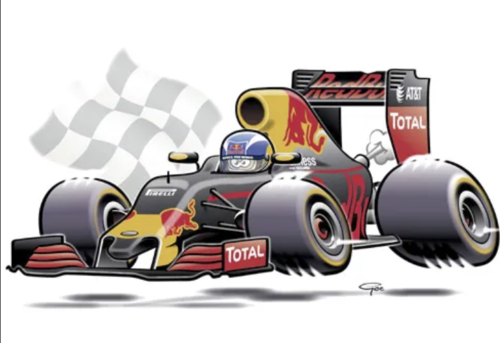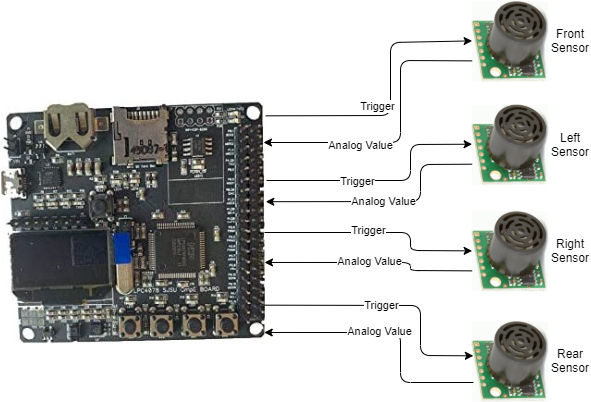Difference between revisions of "S22: Firebolt"
(→FireBolt RC Car) |
(→FireBolt RC Car) |
||
| Line 2: | Line 2: | ||
<div><ul> | <div><ul> | ||
| − | <li style="display: inline-block;">[[File: | + | <li style="display: inline-block;">[[File:Firebolt1.png|thumb|left|600px| The Firebolt]] </li> |
<li style="display: inline-block;">[[File:Firebolt2.png|thumb|right|500px| The RC Car]] </li> | <li style="display: inline-block;">[[File:Firebolt2.png|thumb|right|500px| The RC Car]] </li> | ||
</ul></div> | </ul></div> | ||
Revision as of 09:07, 24 April 2022
Contents
FireBolt RC Car
- File:Firebolt1.pngThe Firebolt
Abstract
Firebolt is battery powered autonomous RC car. The car uses four microcontrollers for communication between the nodes- driver node, motor node, bridge & sensor node, and geological node over the CAN bus. It is interfaced to the mobile application which sends GPS coordinates for the destination location to the driver node and reaches the destination by avoiding any obstacles that comes in the path. For obstacle detection and avoidance it uses Ultrasonic Sensor and makes the decision of steering and maintaining speed after performing calculations based on the bridge and sensor node's data.
Objectives & Introduction
Objectives
The objective of this project is to get hands on experience of application of embedded systems in autonomous vehicles, have understanding of CAN bus communication, CAN database files, TDD and other related tools such as PCAN dongle and Busmaster.
Software side:-
- The car can communicate with an Android application
- Receive coordinates from gps to drive itself to the destination while avoiding obstacles
- Send diagnostic information to the LCD display
- Take care of elevation and make right speeding decisions
- DBC file for all the nodes
Hardware side:-
- Design PCB for four controllers and other necessary components
- Choose good options for mounting the ultrasonic sensors on the car
- Make a good GUI Android application for interfacing with the microcontroller
Introduction
Nodes of the RC Car are:
- Driver Node
- GEO Node
- Sensors and Bridge Node
- Motor Node
- Mobile Application
Team Members & Responsibilities
Priyanka Rai
- Geo Controller
- Bridge and Sensor Controller
- Integration Testing
- Wiki Page Update
Ritu Patil
- Motor Controller
- Integration Testing
- Wiki Page Update
Ritika Beniwal
- Driver Node
- LCD interfacing
- Integration Testing
- Wiki Page Update
Utsav Savaliya
- Sensor Controller
- Integration Testing
- Wiki Page Update
Dhanush Babu
- Bluetooth module interfacing
- Android App
- Integration Testing
- Wiki Page Update
Schedule
| Week# | Start Date | Target Date | Task | Completion Date | Status |
|---|---|---|---|---|---|
| Week 1 |
|
|
|
|
|
| Week 2 |
|
|
|
|
|
| Week 3 |
|
|
|
|
|
| Week 4 |
|
|
|
|
|
| Week 5 |
|
|
|
|
|
| Week 6 |
|
|
|
|
|
| Week 7 |
|
|
|
|
|
| Week 8 |
|
|
|
|
|
| Week 9 |
|
|
|
|
|
| Week 10 |
|
|
|
|
|
| Week 11 |
|
|
|
|
|
| Week 12 |
|
|
|
|
|
Parts List & Cost
| Item# | Part Desciption | Vendor | Qty | Price($) |
|---|---|---|---|---|
| 1 | RC Car | Traxxas [1] | 1 | 280 |
| 2 | CAN Transceivers MCP2551-I/P | Comimark [2] | 5 | 8.99 |
| 3 | Ultrasonic Sensors | Max Botix[3] | 4 | 24.95 |
| 4 | GPS Breakout Board | Adafruit[4] | 1 | 29.95 |
| 5 | GPS Antenna | Adafruit[5] | 1 | 19.95 |
| 6 | RPSMA female to mhf4 | Superbat[6] | 1 | 7.99 |
| 7 | HC05 bluetooth RF Transceiver | HiLetgo[7] | 1 | 15.99 |
| 8 | Triple-axis Accelerometer | Adafruit[8] | 1 | 14.95 |
| 9 | Traxxas RPM Sensor | Traxxas[9] | 1 | 13.76 |
| 10 | Traxxas Battery and Charger | Traxxas[10] | 1 | 62.95 |
Printed Circuit Board
PCB Schematic
PCB Design
CAN Communication
We use controller area network to broadcast data between the 4 nodes. All nodes are connected to each other through a physically conventional two wire bus. The wires are a twisted pair with 120 Ω resistors at each ends of the bus. 1s and 0s are transmitted as CAN High(0V difference) and Can Low(2v difference). A CAN frame has the following contents:
- Data Length Code (4bits)
- Remote Transmission Request.
- ID extend bit.
- Message ID (11 bit or 29 bit)
- Data bytes( depends on DLC)
- CRC
Arbitration: No two nodes will transmit at the same time because if arbitration. A lower Message-ID has a Higher priority on the CAN bus since 0 is the dominant bit.
Bit Stuffing: CAN bus stuffs extra bits when a long chain of multiple 1's or 0's occur to improve CAN integrity.
| Sr. No | Message ID | Message function | Receivers |
|---|---|---|---|
| Driver Controller | |||
| 1 | speed and steering direction for the motor. | Motor | |
| 2 | Destination reached | Sensor | |
| Sensor Controller | |||
| 1 | Sensor sonars from front, back, left ,right sensor | Driver | |
| Motor Controller | |||
| 8 | motor speed, motor direction | Driver | |
| Geo and Bridge Controller | |||
| 1 | Bearing, Heading and Distance | Driver | |
| Debug messages | |||
| 1 | Driver Debug | SENSOR,MOTOR,GEO_AND_BRIDGE | |
| 1 | Motor Debug | SENSOR,MOTOR,GEO_AND_BRIDGE | |
| 1 | Sensor Debug | SENSOR,MOTOR,GEO_AND_BRIDGE | |
Hardware Design
DBC File
The DBC file is a simple text file that consists of information for decoding raw CAN bus data to physical values or in human readable form.
Sensor ECU
Hardware Design
Sensor Controller Schematic
Board Pin Connections
Sensors are interfaced with combination of GPIO, ADC Pins on SJTWo board. Below is the descriptive pin layout:
Software Design
Technical Challenges
Neighboring Sensor Interference:
Frequent noisy measurements:
Motor ECU
Hardware Design
Software Design
Technical Challenges
Geographical And Bridge Controller
Hardware Design
Software Design
Technical Challenges
Driver Node
Driver Node is the master controller. It receives input from sensor and bridge node, processes it to make right decision for controlling the speed and steering direction of the car and finally commands the motor node to drive accordingly. This node is also interfaced to an LCD, which acts as dashboard of the car and displays information such as car speed and distance to destination on the screen.
Hardware Design
Software Design
Technical Challenges
Mobile Application
User Interface
Software Design
Maps Activity
Bluetooth/WIFI
Technical Challenges
Conclusion
Project Video
Project Source Code
Advise for Future Students
Acknowledgement
References
http://socialledge.com/sjsu/index.php/Industrial_Application_using_CAN_Bus

